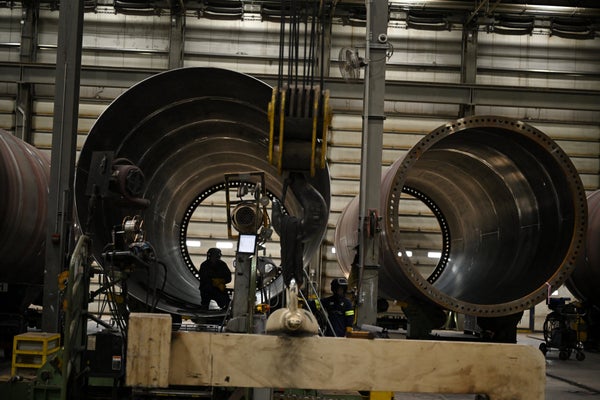CLIMATEWIRE | Renewable energy is breaking records across the U.S.
Wind and solar accounted for 76 percent of electricity production in Texas’ primary power grid last Friday. The next day, New England set its own record, with 45 percent of its power coming from wind, solar and hydropower.
Within the last month, grid operators have reported record solar generation in the Midwest, record wind generation in New York and record renewable generation in the mid-Atlantic, according to data collected by GridStatus.io, a website that monitors electricity markets around the country.
On supporting science journalism
If you're enjoying this article, consider supporting our award-winning journalism by subscribing. By purchasing a subscription you are helping to ensure the future of impactful stories about the discoveries and ideas shaping our world today.
The milestones represent a snapshot in time, a mere hour of a day when renewable generation surges on one of the country’s regional electric grids, all of which remain firmly dependent on fossil fuels.
But together they paint a picture of an evolving power system. Wind generated almost twice the electricity as coal last year on the grid managed by the Electric Reliability Council of Texas, which serves about 90 percent of the state's power demand. Rooftop solar regularly tops generation in New England on sunny days.
Even gas- and coal-rich grids like PJM Interconnection, which runs through states from New Jersey to Illinois, have started to observe a shift. All of PJM’s top 10 days for solar generation have occurred within the last two months, though renewables remain a fraction of the grid's total power mix.
“It shows how quickly you can add these new resources,” said Ric O’Connell, executive director of GridLab, a clean energy consulting firm. “We can move fast. These grids do evolve quickly.”
The records owe in part to the changing season. Mild spring temperatures mean demand eases for heating or cooling, resulting in less electricity consumption. That, coupled with growing solar and wind generation, pushes up the percentage of green energy on grids across the country.
But the records also reflect several years of robust renewable growth. Developers installed 60 gigawatts of new solar capacity nationally between 2019 and 2023, double the amount installed in all years prior, according to Energy Information Administration data. Wind capacity is up 57 percent over that period, despite a lag in installations last year, the federal figures show.
Easing of supply chain constraints, coupled with federal tax credits for clean energy, have accelerated the trend. The U.S. installed 32.7 GW of new battery, solar and wind capacity last year, beating the record of 31.5 GW set in 2021, EIA data shows.
But whether renewables can continue to grow at the rate needed to drive down emissions and meet an expected spike in electricity demand is an open question. The Rhodium Group, an energy modeling firm, estimates the U.S. needs to install between 32 GW and 95 GW of new wind and solar capacity every year through 2035 in order to cut emissions 32 percent to 51 percent compared to 2005 levels.
“From a climate perspective these records are great, but they are still not enough to get emissions down to the level we want,” said Melissa Lott, a professor who studies the power sector at Columbia University’s Climate School.
The renewable records come at a critical moment. Grid operators are sounding alarms about their ability to keep pace with projected increases in electricity demand, which is expected to grow due to a proliferation of new data centers, electric vehicles and heat pumps.
PJM anticipates that electricity demand will grow by an average of 2.3 percent annually over the next 10 years, up from the 1.4 percent growth it predicted last year. ERCOT set 10 new demand records over a one-month period last summer. The New York Independent System Operator thinks the combination of rising demand and retiring fossil fuel generators could leave New York City facing a shortage of energy supplies by 2026.
"We need to grow the resources much quicker than we are,” said Kevin Lanahan, vice president of external affairs at the New York Independent System Operator, where renewable generation reached a record 44 percent of load March 17.
There is a growing imbalance between new facilities coming online and the amount of power needed to keep the system running, he said.
He added, “we’re concerned about that growing imbalance and we need to site more resources on the system to fill this growing gap.”
Renewables and other carbon-free electricity sources need to grow faster than electricity demand for emissions to fall. But new projects face challenges connecting to the grid. They range from clogged interconnection queues, with grid operators facing a stack of applications from developers seeking to plug in their projects, to siting and transmission constraints.
Still, the renewable records posted in recent weeks show that it is possible to move quickly to address those challenges, said GridLab’s O’Connell. He pointed to recent installations in Texas and California.
ERCOT has added more than 14 GW of new solar since 2020, or about 16 percent of the Texas grid’s peak demand. Almost 7.5 GW of new battery capacity was added to the California Independent System Operator’s system between 2021 and 2023, or about 14 percent of the Golden State’s peak demand.
“That’s a lot,” O’Connell said. “The future is here.”
This story also appears in Energywire.
Reprinted from E&E News with permission from POLITICO, LLC. Copyright 2024. E&E News provides essential news for energy and environment professionals.
